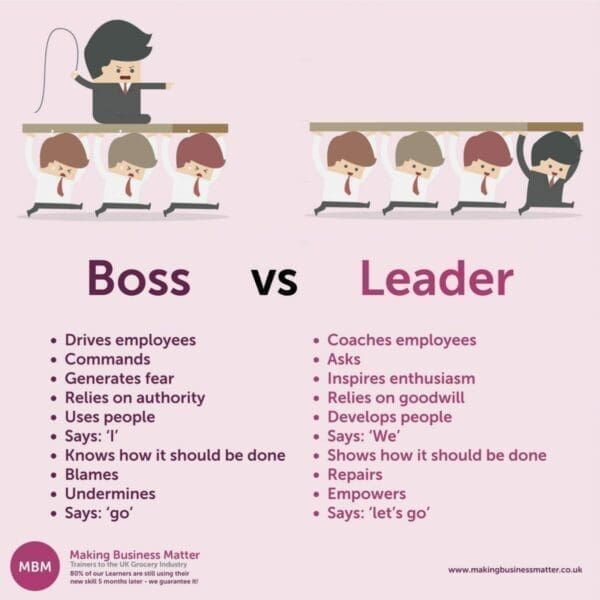Take a Fresh Look at Business Thinking in the Post-Pandemic Era
Management vs leadership – how do a leader and manager fit together? Why is there this tension? How can we resolve it? Is there another, more engaging way to run businesses?
The pandemic has seen businesses formulating bold new strategies and challenging traditional wisdom about management and leadership. So what happens next?
In this article, we look at the relationship between management and leadership and ask if employee ownership could heal the divide.
In the UK, John Lewis famously led the way in employee ownership. Recent followers include Aardman, richer sounds, Riverfords and various marketing agencies. There’s a mental shift when you own something. It’s all about what needs to be done, rather than what you want to do. And this shift helps drive success in employee-owned businesses.

Why Do We Say it’s ‘Management vs Leadership’?
To answer that, we need to go back to basics. Entrepreneurs start enterprises and lead them to success. As they grow they bring in management to implement their vision and find successors. But what sort of people should these successors be? Put crudely, leaders challenge and bring fresh thinking, however disruptive it may be, and managers maintain the status quo. Which do you want? Or need?
This dilemma has kept writers and academics busy for decades. In 1977 Abraham Zaleznik wrote an article in Harvard Business Review, in which he challenged the traditional management doctrine. Further, the model, he argued, omits the ‘leadership’ elements, inspiration, vision and passion, essential to corporate success.
Zaleznik insisted true business leaders have more in common with artists than managers. Leaders tolerate chaos and lack of structure, whilst managers seek order, control and rapid resolution of problems. However, companies need both to excel, but too often don’t create the right environment for leaders to flourish.
Kotterman’s Take
In 2006, James Kotterman wrote an article entitled Management vs Leadership, in the Journal for Quality and Participation. He felt the idea of management was being downgraded in popular perception. Kotterman wrote:
“Leaders are seen as charismatic and often admired and held in high esteem. But managers are often thought of as taskmasters – whip in one hand, bullhorn in the other. Is there really a difference, or are the perceived differences simply a matter of style?”
In 2013 John Kotter wrote: “Very few organisations today have sufficient leadership. We recognise we’re not talking about management when we speak of leadership. Otherwise, when we do need more leadership all we will do is work harder to manage. We will end up with over-managed and under-led organisations, increasingly vulnerable in a fast-moving world.”
To explore these ideas further, let’s look at some fundamental questions.
What is the Definition of Leadership and Management?
Leadership is concerned with setting a new direction or vision, with a leader as the spearhead. Meanwhile, management means controlling or directing people and resources following principles or values established by the leadership.
Sticky Learning ® is 7 times more effective than 1-day training courses. Plus, you will get a Chain of Evidence proving your Return on Investment. Discover soft skills training that changes behaviours long term.

What is the Difference Between Leadership and Management?
Leadership is about getting people to comprehend and believe in your vision for the company and working with you to achieve your goals. Whereas, management is making sure the agreed day to day activities happen as they should.
Can a Leader Also be a Manager?
If you run your own business, you have to be both! Judging when to switch hats is the trick, and it’s all about strategy. Managers optimise the organisation and people to meet strategic goals, whilst leaders drag the organisation and its goals into a strategic future.
Can You Give Me an Example of the Difference?
Leadership always involves leading people, but management doesn’t necessarily involve organising people. It can concern responsibility for things like advertising, premises, equipment or tech. If the two functions don’t communicate, this can lead to conflict.
What are the Main Conflicts Between Leadership vs Management?
The goals of the leadership and the challenges of the management aren’t necessarily the same. When they pull in different directions, it can create friction! Managers get frustrated about moving targets and shifting expectations, or system and process changes. Then, they feel disconnected from the leadership and misunderstood, underappreciated and not heard.
So How Do You Define Management?
In its wider sense management is the process of guiding the development, maintenance and allocation of resources to attain organisational goals. This involves four key functional areas: planning, organising, controlling and – wait for it – leading.

So Management Also Includes Leadership!
Yes, leadership in its narrower sense is probably the most important function of business management. It helps maximise efficiency, which helps achieve the business’s vision and goals.
I feel your pain. Things become clearer when we compare leadership vs management in the NHS. In their model:
Management involves a process, reduced risk, consistency, replicate, incremental, direct/mentor, short term, structure/control, and procedure.
Leadership involves people, risks, change, innovation, transformative, coach/delegate, longterm, empower and vision.
In the NHS, most senior people promoted from the ranks need first to consolidate their basic management skills. Then consider if they want to become a future leader. In business there’s less hesitation: often, talented people grab their opportunity and the business faces the consequences.
‘Management vs Leadership’ By Numbers
Explaining things using numbers will help make this easier to grasp.
What are the Three Types of Management?
In the 1930s Dr Kurt Lewin identified three broad types of management style: democratic, autocratic and ‘delegative’, or laissez-faire. When the three overlap like a Venn diagram, it’s reckoned to be the perfect managerial leadership.
What are the Three Managerial Roles?
Managers’ roles fall into three categories:
- Informational – information gatherer, distributor, spokesperson.
- Interpersonal – figurehead; liaison between individuals or departments; leader.
- Decisional – entrepreneur, crisis handler, resource allocator, negotiator.
What are the Three Levels of Management?
Levels of management can be classified into three categories, which direct managers to perform different functions:
- Administrative, managerial or top level.
- Executive or middle level.
- Supervisory, operative or lower level.
A Quick Aside – Who is Considered Upper Management?
‘Upper management’ generally includes individuals and teams responsible for the primary decisions within a company. They are at the top of the corporate ladder and carry more responsibility than lower level personnel.
What are the Three ‘Ships’ of Management? (We Like This One!)

- Leadership
- Mentorship
- Ambassadorship
What is the Four-Tier Pyramid?
This model is also known as the four levels of management. But having said there are THREE levels just now, let’s not confuse things! A typical IT department has a hierarchy of management, like a pyramid. From the top down:
- Executives – executive information systems.
- Senior managers – decision support systems.
- Middle managers – management information systems.
- Workers – transaction processing systems.
What are the Five Principles of Management?
In his 1916 book “Administration Industrielle et Generale,” Henri Fayol identified five functions: planning, organising, commanding, coordinating and controlling.
What are the Five Steps in Management Decision Making?
- Recognise the problem or opportunity.
- Gather information to identify solutions or actions.
- Select alternatives based on their strengths or weaknesses.
- Put the chosen alternative into action.
- Gather information and evaluate effectiveness.
Leaders Wanted – Apply Within
Boss vs Leader
Being ‘the boss’ isn’t always a good thing, unless you’re Bruce Springsteen. Much better, be a leader. Because a boss manages their employees, whereas a leader inspires them to innovate, think creatively, and strive for perfection.

What’s the Difference Between Leading and Controlling?
Leading is about managing, motivating and directing people, whilst controlling is about monitoring and evaluating activity. But please note, controlling shouldn’t be confused with micromanaging! Micromanagers are essentially hands-on managers who overstep the bounds of management. Also, they assign tasks then hover over people while they complete the job.
What’s the Difference Between Management Skills vs Leadership Skills?
There are five recognised management skills:
- Organisation
- Attention to detail
- Communication
- Time management
- Delegation
And five essential leadership skills:
- Vision
- Curiosity
- Communication
- Emotional intelligence
- Accountability
The difference is about empathy.
How to Become More of a Leader
You needn’t be a senior manager to show leadership traits. You can become a great leader starting where you are now. Follow these simple steps:
- Practise the long term view: read up on what’s happening and share it with your team.
- Develop your emotional intelligence: reflect on how you react to people and circumstances: pay attention to your feelings.
- Become a lifelong learner: commit to stepping outside your comfort zone and learning new skills: get comfortable with being uncomfortable.
- Ask for input. Being an effective leader means listening to feedback. Managers delegate, but leaders encourage others to take ownership of their work.
Carry on Up the Jungle!
Hopefully, it’s getting clearer now. Let’s ponder some more questions.
What’s the Difference Between Change Management and Change Leadership?
Change management uses a set of tools to bring about a controlled change. Change leadership is a proactive approach to change management, where change is seen as an opportunity for growth and improvement.
How is Transactional Management Different to Transformational Leadership?
Transformational leaders inspire and motivate followers in ways that go beyond exchanges and rewards. Whereas, transactional leadership is based on exchanges between the leader and follower, in which followers are rewarded for meeting specific goals or performance criteria.
What are the Ten Differences Between Leadership vs Management?
- Managers set goals but leaders set the vision. It’s the manager’s job to turn it into reality.
- Managers usually think short term, leaders think long term.
- Leaders are in favour of change, managers maintain the status quo.
- Managers don’t like leaving their comfort zone: leaders take risks. Leaders aren’t afraid to fail sometimes.
- Managers are process-focused, leaders are people-focused. Leaders know when their people grow, the business grows too.
- Managers supervise the team, leaders coach the team.
- Leaders don’t micromanage, they guide people towards the vision.
- Managers are authoritative, leaders are charismatic. Leaders have fans, managers have employees.
- Managers are controllers and think with their brains, leaders are passionate and think with their hearts and their brains.
- Managers do things right, leaders do the right thing. If leaders need to break rules and set new ones, they don’t hesitate because leaders are open to change.
It’s All About YOU
Do You Know the Difference Between a Good Manager and a Good Leader?
- Good managers find people to fit the mould, great leaders break it.
- A good manager lets you work, a good leader makes you want to!
You’re Running the Show. But Are You a Manager or a Leader?
Try these tests to see if you’ve made the shift from managing people to leading them:
- Do you count value (you’re a manager) or create it (you’re a leader)?
- Are you leading people or managing work?
- Do you create circles of power (a manager) or circles of influence (a leader)?
The more people outside your team come to you for advice, the more likely you are to be a leader.
How Can I Tell if I’m a Better Manager or Leader?
There are lots of quizzes online. You must be honest with yourself, as always with these things, but give them a go and see how you do!
A Possible Third Way – Employee Ownership
As we’ve learnt from the pandemic, it’s critical that staff feel valued, listened to and respected. So, the ‘management/leadership’ model may no longer be enough to attract good people and keep them motivated.

One solution might be an Employee Ownership Trust or EOT. This is a specialist version of an employee benefit trust, introduced by the UK government in 2014. Also, shareholders sell their shares into a trust held on behalf of the employees.
EOTs mean that people get rewarded more for their contribution to the business’s success. Also, engagement and productivity levels are higher, and in return, the team’s wellbeing is a top priority.
The EOT survey 2019 shows there are 241 verified EOT-owned companies in the UK. And a further 34 EOT-owned companies established for longer, known as ‘deemed EOTs.’ The most famous employee-owned business is John Lewis. But EOTs are also growing in popularity in manufacturing and professional services, including marketing agencies.
What are the Pros of Employee Ownership Trusts?
Employees have greater involvement in the business, so are more motivated and innovative.
As they’re more involved, it reduces absenteeism too. Other benefits include:
- Tax-free bonuses for employees.
- Higher staff retention – and attracting staff.
- Co-owned companies can be more successful, profitable and sustainable.
- Shareholders get a full Capital Gains Tax exemption.
- Corporation tax deduction for companies providing share incentives.
- Quicker and smoother sale of the business.
What are the Cons?
EOTs have benefits but they’re not right for everyone:
- It still takes hard work and commitment and won’t protect you from market pressures
- Indirect ownership: the company doesn’t have full control
- You need to trust the trustees to behave with good conduct
- Shareholders won’t receive the money from the sale immediately so they take on more risk
- It’s complex and potentially expensive BUT doesn’t cost more or less than a ‘normal’ sale
So are you a company owner? Would an EOT work for you? They could well do. That’s if you’re thinking of retiring or interested in succession plans. Or it could fit if you’re a medium-sized company with 50 to 250 employees.
And Finally… An Apple For the Teacher

In some successful businesses, management like everything buttoned-down, but they value magnetic personalities as much as proficiency. At Apple stores, word has it they used to ask candidates three basic questions. Can you offer our level of service? Do you display grit? And how would you get on with Steve Jobs?
If a candidate has an opinion, and can articulate it and is willing to fight for it, that’s leadership material. Because leadership needs confidence and fearlessness about offering feedback, pushing back on ideas and arguing your point – even with a legendary CEO!
Action: For even more useful content on leadership, check out our ultimate guide on Leadership Skills.




